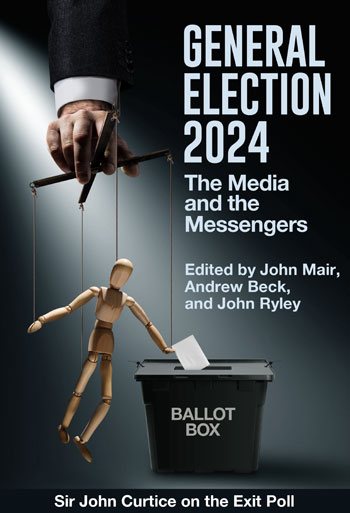
Scrolling through their phones on the sofa to avoid the TV news being watched by their parents, many of our students have a particular view about the usefulness of old school political journalism when it comes to deciding how to vote. In 2023, our MA Journalism students, some of whom are late millennials, thought that Reith’s BBC public service mission needed an extra dimension to Inform, Educate, Entertain … and Engage.
Plus ça change
Back in the 1980s and 1990s, we were cutting news packages that were full of tropes, playing to the politicians, with their pre-election antics: the campaign trail, ‘pressing the flesh’ meet and greets, picking up children, and that dreaded white shirt with no tie and carefully rolled- up sleeves.
Then, on 16 May 2024, Sir Keir Starmer, announced his ‘Six First Steps for Change’, in that same white shirt, sleeves rolled up, not as meticulously as some others in recent history, but nearly up to his elbows and with his tie off. Noticeably, the tie is on in the promotional poster next to him, albeit with no jacket, but said wardrobe article is definitely off, with top button undone, for the cameras on announcement day. How tiresome the trope, and how tedious for the Gen Z demographic who might be looking for something new, or some original creative digital content, with which to engage.
Speaking to a Gen Z post-graduate student about where she would go for digital content relating to the upcoming election, she replied, “I’m not bothered”. She is not alone. Perhaps this is not surprising given the reductive, often binary and two-dimensional, way we still have of telling so many political news stories in the mainstream media today. On 22 May, soon after Rishi Sunak had announced 4 July as general election day, Starmer appeared, this time in suit and tie and studious glasses, at his presidential lectern, flanked by not one but two Union flags and his media-ready slogan ‘stop the chaos’ mirroring, in no uncertain terms, Boris Johnson’s ersatz Churchillian presentation of himself as ‘oven-ready’ for his own term in office.
As political parties scramble for media attention, will journalists focus on what really matters and will they engage the younger generations, who need to decide how to vote? Never mind the policies, watch out for the hard hats and hi-vis jackets as political leaders go out on the campaign trail.
Message or massage – what should we expect?
During the 2015 UK election campaign, there was an intermedia agenda-setting influence led by the national press, whose front-page splashes apparently dominated the television coverage too (Cushion et al, 2018). It has forever been the case that controversies make news, and as the
Glasgow Media Group told us, these could be Bad News, More Bad News, or Really Bad News. However, since the advent of rolling bulletins, with their waves of repeating material, the need to punch through with Breaking News has perhaps exacerbated the search for these controversies. With clickbait going viral, journalists reacting in the moment, to create traction for their content, are sometimes adversely shaping agendas, while these controversies drown out other topics that perhaps ought to have had centre stage.
For example, on 2 May, the day of the recent local elections, TV coverage across BBC, ITV, and GB News was dominated by stories about Angela Rayner’s alleged misdemeanours. As a deflection, or a distraction, or to help citizen deliberations one might wonder. Or was it just clickbait produced to attract consumer attention?
The values of public service broadcasting should include informing in such a way that improves political decision-making, especially during a season where citizens are expected to vote. Brexit was a case in point, where contentious issues, and images of immigrants arriving on boats, were allowed to be conflated with what we were supposed to be voting about.
The youngest adult voters now, currently dubbed Gen Zee, may or most likely may not engage with the media conduits adopted by their parents. But is this really their fault, given the predictable content on offer? As Professor Stephen Coleman reminded us, at the 2024 Jay Blumler Lecture ‘the Register of Disenchantment, the News Media, gets on their nerves’.
During the Covid pandemic, TikTok came into its own. Not only did it morph from dance platform to #Wuhanoutbreak news disseminator, in its second wave, it went through short-form banana-bread baking and other broader home-based content, but still with an Asia-Pacific focus about the virus. A third wave began to be dominated by UK and US discourses with content now relating to elections and ‘speculative futures’ (Abidin et al, 2023) and much of it wrapped up as entertainment as much as information. There were influencer content pivots more generally (ibid) as the fear of the pandemic was punctuated with humour, and hard facts started to be disseminated to young people in ways that continued to engage them, as the world started to open up again.
How much of a role this platform will play in persuading new voters to vote, and which way, remains to be seen. With its catastrophising hashtags, X can also pull and push opinion. But will any of it burst the bubbles of existing tribal echo chambers?
Many of our university students are bored with politics, at least the way it is framed in the media, with personalities no one can trust and a sense of futility that any change can be made. For some, voting red or blue is akin to the pre-selected colour of their football team, defined by their parents or their family narrative, or even where they live. Reporting the campaign process instead of dissecting the policies will switch them off again, alongside the leaderboard statistics of the ‘who is winning?’ horse-race coverage that many of them say they won’t be watching.
A very keen undergraduate who did her placement during the 2024 local elections said she was surprised, during the hours of the vote count, “to find both parties laughing and joking together” as she didn’t realise they could get on well together. The media, she thought, made it “seem like they hate each other, but they don’t”.
That binary portrayal of ‘us’ versus ‘them’ serves no one who wants to make their society a better place. She wanted a place online where you could see a list of what every party, including the independents, would plan to do ‘and that’s very hard to find’. Hard to find for a journalism student. How much harder for those not used to research?
A change at the helm should not be a sport, and these viewers will be watching other content, or so they tell me in class. ‘What is the point?’, ‘Who cares?’ they say, as they feel they don’t have any agency anyway.
Impartial or independent?
On 20 May, Ofcom found that GB News’ one-hour special programme The People’s Forum: The Prime Minister broke broadcasting rules by not presenting an ‘appropriately wide range of significant viewpoints’. As Ofcom considered this to be a ‘serious and repeated breach’, they were starting ‘the process for consideration of a statutory sanction against GB News’. In need of balance, the poor British public might be tipped in the wrong direction, if they weighed up their thoughts, based on a single programme like that. One might argue that the beauty of our liberal and pluralistic media system is that it is not state-controlled with only a single message, and that you can go online to, say, the Daily Mail and then to The Guardian for different points of view, to make up your mind for yourself.
Certainly, both these right and left papers provide extensive teaching material for understanding the construction of meanings and the discovery of not-so-hidden ideological standpoints. But should we eliminate contentious content that seeks to engage as well as entertain? Or do, for example, these media outlets, alongside many others, provide part of a healthy diet for those engaged in the political process? We have first-time voters in our universities who are avoiding the polls as well as the media coverage, but who are happy to complain online.
The BBC’s Birtian ‘mission to explain’, coupled with the emotional turn identified in both media and politics (Wahl-Jorgensen, 2019), could work well to engage these young digital natives, but only if we set aside the tropes and gimmicks that so far, at least, are not yet working for them.
References
Crystal Abidin and Naomi Robinson (2023). A Retrospect on Young People and COVID-19 Discourse on TikTok, TikTok Cultures Research Network (TCRN), Centre for Culture and Technology (CCAT), Curtin University.
Stephen Cushion, Allaina Kilby, Richard Thomas, Marina Morani, and Richard Sambrook (2018) ‘Newspapers, Impartiality and Television News: Intermedia agenda-setting during the 2015 General Election campaign’, Journalism Studies, 19:1, pp.162-181
Karin Wahl-Jorgensen (2019) Emotions, Media and Politics, Cambridge: Polity Press.

This chapter is taken from the new book, ‘General Election 2024: The Media and the Messengers’, edited by John Mair, Andrew Beck and John Ryley.












